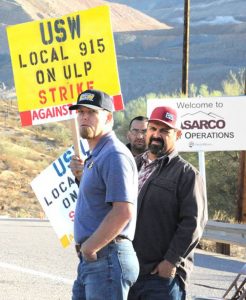
Labor struggles are picking up as workers grow more confident they can organize to stand up to the bosses’ attacks. Some 3,600 workers at Mack Truck went on strike this week, as well as 2,000 Asarco copper miners in Arizona and Texas, reinforcing the fight of nearly 50,000 UAW members on strike at GM, who got word of a tentative agreement Oct. 16.
These UAW members are fighting against the divisions GM bosses have imposed to extract higher profits, with lower pay for newer workers, and growing numbers of temps.
Chicago City Hall announced it will close schools Oct. 17 because the teachers union says it has little choice but to go on strike like it did in 2012. Drivers at e-hail companies have organized protests against bosses’ pay cuts and schedule abuses. When the lights went out at a Walmart store in California and the bosses demanded workers strap on flashlights and keep working, a layer of workers walked out — and weren’t victimized.
With unemployment at a low ebb, more workers see the chance to claw back some of what the bosses have taken from us.
Despite today’s economic uptick, workers continue to face stagnant wages, job insecurity, declining health care, growing indebtedness, more difficulties in being able to afford to get married, get a home and raise a family. And we bear the deadly toll of Washington’s wars around the world.
In these conditions working people have watched protests in Sudan, Hong Kong and elsewhere that have shaken hated rulers, showing our potential power.
Two things are key to today’s working-class battles. First is the unity of the workers — beating back efforts of the bosses to pit us against each other. Employed and unemployed, full-time and temp, immigrant and native-born, Black, Hispanic and Caucasian, men and women standing together for each other in struggle.
Second is organizing solidarity with the fights that break out today — this is crucial for their success. The bosses do everything they can to keep our battles out of the media, to prevent union fighters from getting a hearing. They try to turn other workers against those who stand up to attacks.
The employing class is aided by both the left and right of capitalist politics who scornfully attack the rights of working people — whose labor produces all wealth — as “deplorables” needing to be held in check.
The Militant urges readers to spread the word about these fights, win support and bring others to meet fighting workers on the picket lines. Seeing our common cause raises workers’ self-confidence and consciousness of ourselves as one powerful social class. It helps us grapple with broader political questions in class terms.
The Militant tells workers’ side of the story and is a tool for building solidarity. Alongside books by revolutionary working-class leaders distributed by Socialist Workers Party members, the paper places today’s labor battles in continuity with working-class struggles over decades. It points the road forward — to building the kind of party needed to lead millions in revolutionary struggle that can replace capitalist rule with workers power.

